How many people are detained or returned?
Published 24 November 2022
Back to ‘Immigration statistics, year ending September 2022’ content page.
This is not the latest release. View latest release.
Data relate to the year ending September 2022 and all comparisons are with the calendar year 2019 (unless indicated otherwise), reflecting a comparison with the period prior to the Covid-19 pandemic.
Data on returns relate to the year ending June 2022, which is 3 months before the reporting on detention and other Immigration system data, to allow more time for returns to be recorded on the system and ensure the published figures are an accurate representation of the number of returns. See the user guide for more details.
Year ending comparisons that follow will include impacts resulting from the restrictions in place during this period of the pandemic. All data include dependants, unless indicated otherwise.
1. Immigration detention
An individual may be detained under immigration powers under certain circumstances, for example, whilst their identity is being established, where there is a risk of absconding, or in support of the return of an individual with no legal right to be in the UK. Where an individual is being detained in support of a return, detention may continue lawfully only for as long as there is a realistic prospect of removal within a reasonable time period. More information is provided below.
1.1 People entering immigration detention
23,226 people entered immigration detention in the year ending September 2022, this represented a decrease of 5% compared with pre-pandemic levels in 2019. The profile of detainees and their length of detention, however, has changed. Since the pandemic, a higher proportion of those entering detention have been small boat arrivals who have been detained in order to confirm their identity and register their asylum claim. Where an asylum claim can be considered (and rejected) in a reasonable time frame, detention is maintained for return. Where it cannot, the individual is released while their claim is considered. Prior to the pandemic the predominant use of detention was preparation for return. Not all small boat arrivals enter the detention estate, with some being held in short-term holding rooms (not counted in this data) for short periods of time in order to establish their health and safety, and secure their identity, before being dispersed to other appropriate accommodation. Please see the ‘About the statistics’ section below for more information.
Figure 1: People entering immigration detention in the UK, year ending September 2013 to year ending September 2022
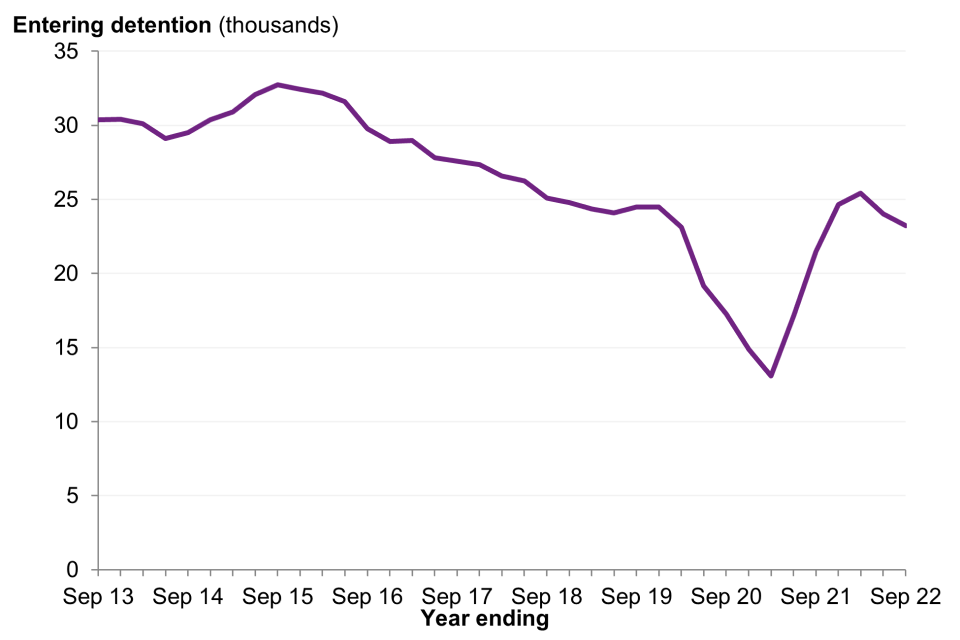
Source: Immigration detention - Det_D01
Figure 1 shows that there had been a general downward trend in the number of people entering detention from the peak in 2015, when around 32,400 people entered detention to around 24,500 in 2019. During the pandemic, the number of people entering immigration detention reached a low of around 13,000 in the year ending March 2021.
The top 10 nationalities entering immigration detention currently reflect the same nationalities as recent clandestine arrivals to the UK via small boats (as reported in the Irregular Migration to the UK, year ending September 2022, Home Office report), emphasising the role immigration detention has played in managing these new arrivals. The exceptions are Romanians and Brazilians, who are more likely to have entered immigration detention for other reasons, such as criminality or overstaying a visa, and may be being prepared for their return.
Albanians were both the most common nationality arriving via small boat and the most common nationality entering detention in the year ending September 2022, accounting for 33% of the total, or 7,775 entrants, more than double pre-pandemic levels in 2019 (3,483). Albanians also feature prominently among Foreign National Offender numbers, as mentioned in section 2.2 below.
Afghans entering detention also more than doubled in the year ending September 2022 compared with 2019 from 463 to 1,188, with Afghans being the second most common nationality arriving via small boat from January to September 2022. Other notable increases for nationalities prominent in small boat arrival numbers are Iranians and Iraqis for whom numbers entering detention have increased 34% and 57% respectively, compared to 2019.
The majority of other nationalities (including Romanians and Brazilians) entering detention, however, remained below pre-pandemic levels.
1.2 People in immigration detention
At the end of September 2022, there were 2,077 people held in immigration detention (including those detained under immigration powers in prison), almost 3 times more than at the end of June 2020 (698) when the impact of the pandemic was most pronounced and 27% more than immediately prior to the pandemic at the end of December 2019 (1,637). However, the number detained at the end of September 2022 was 25% lower than at the end of March 2018 (2,758).
Figure 2: People detained under immigration powers in the UK, by place of detention, as at the last day of the quarter, January to March 2018 to July to September 2022 1
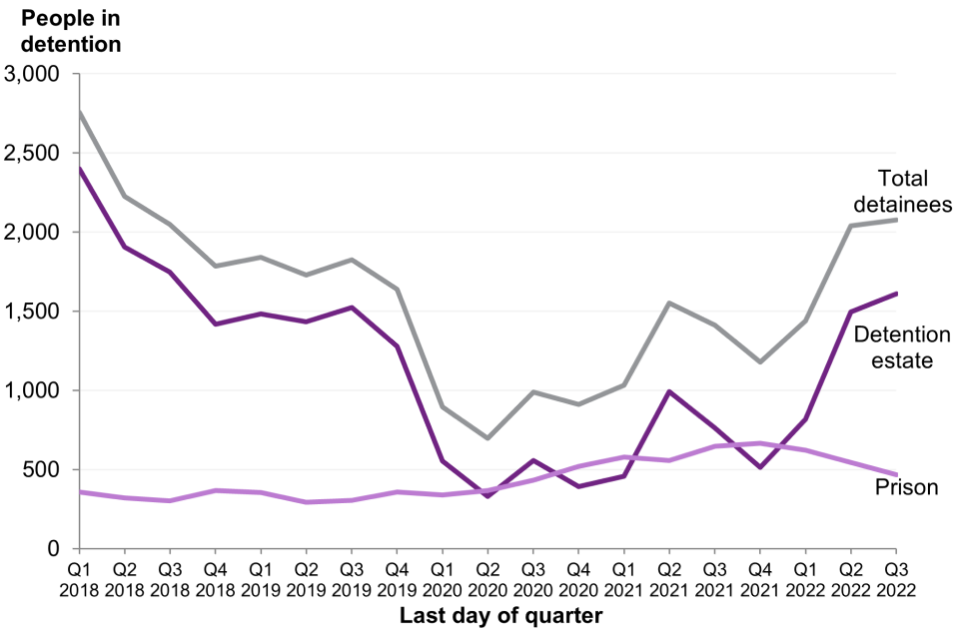
Source: Immigration detention - Det_D02
Notes:
- The ‘detention estate’ comprises Immigration Removal Centres (IRC), Short-Term Holding Facilities (STHF) and Pre-departure Accommodation (PDA). It is separate to those who are detained under Immigration powers in prisons – these are shown separately on the chart.
Figure 2 shows the number of people detained in the detention estate fell immediately following the pandemic but has now risen above pre-pandemic levels (1,610 at the end of September 2022 compared with 1,278 at the end of December 2019, before the pandemic), although was still lower than the number of people detained in the detention estate at the end of March 2018 (2,400).
The number of people detained in prisons under immigration powers increased, from 359 before the pandemic at the end of December 2019 to 665 at the end of December 2021. This increase over the pandemic may have reflected difficulties in securing returns due to the global travel restrictions caused by the pandemic, as well as challenges around releasing some foreign national offenders (FNOs) into the community. Numbers have however started to decrease, with 467 people detained in prisons under immigration powers at the end of September 2022.
The number of people in detention relate to a specific point in time and are subject to daily fluctuations. For example, if there were a large number of clandestine arrivals who had to be brought into detention just before the end of the period, the number of people in detention may be higher than if the same arrivals occurred a few days later.
1.3 People leaving immigration detention
The majority of detainees were detained for short periods on arrival to the UK before being bailed.
Figure 3: People leaving immigration detention, by length of detention1, year ending September 2018 to year ending September 2022
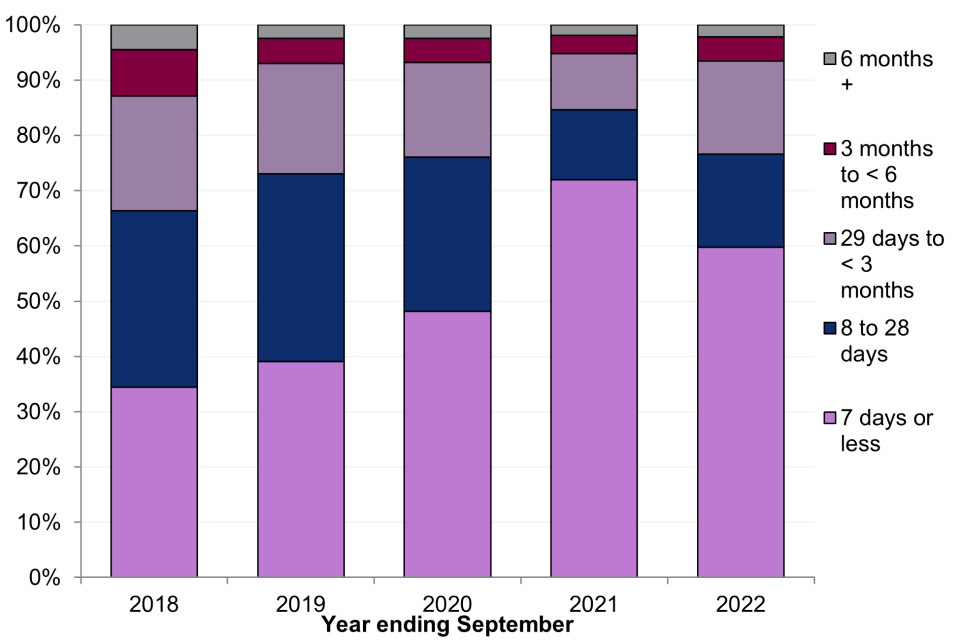
Source: Immigration detention - Det_D03
Notes:
- < means ‘less than’.
Figure 3 shows that the proportion of people who left detention in the year ending September 2022 who were detained for 7 days or less was substantially higher than in the year ending September 2019 (60% compared to 39%); however, this proportion is lower than the year ending September 2021 (72%).
This high proportion is in part due to an increasing proportion of detainees being bailed (82% of those leaving detention in the year ending September 2022 were bailed), with the most common reason being an asylum (or other) application being raised. This again reflects the increased use of detention for new arrivals rather than preparation for return.
Combined with lower numbers of enforced returns compared to 2019, this has led to a smaller proportion of detainees being returned from detention; 17% (3,924) in the year ending September 2022, down from 37% (9,081) in 2019 pre-pandemic and 64% (16,577) in 2010.
Figure 4: Top 10 nationalities leaving detention by reason for leaving1,2, year ending September 2022
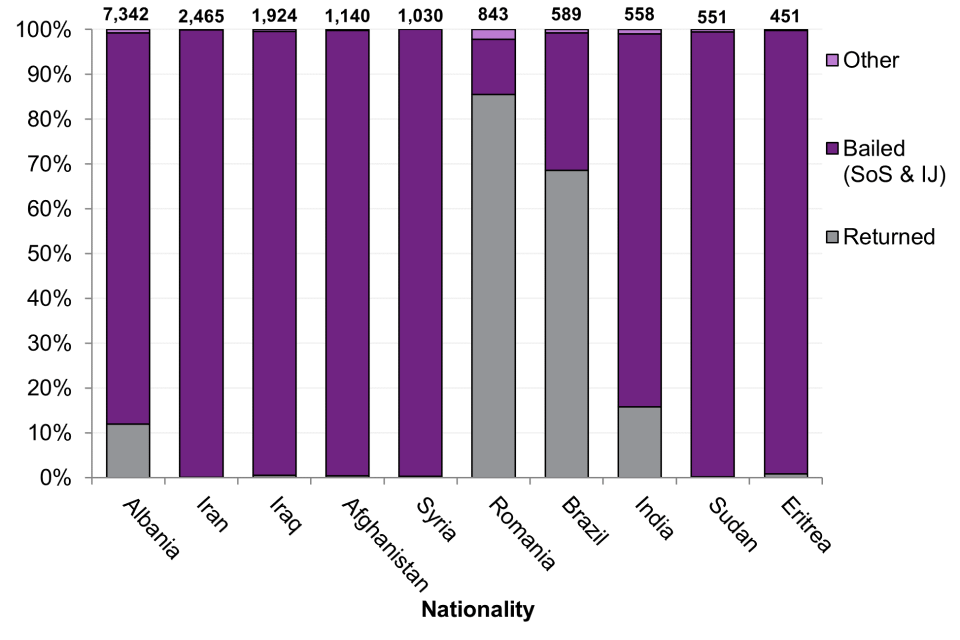
Source: Immigration detention - Det_D03
Notes:
- Bailed Secretary of State (SOS) & Immigration Judge (IJ).
- Other reasons for leaving detention include being sectioned under the Mental Health Act, entering criminal detention, being granted leave to enter or remain in the UK, and detained in error. See the user guide for more details.
Figure 4 shows that among the top 10 nationalities leaving detention in the year ending September 2022, in most cases the individual was bailed. However, for Romanians (6th) and Brazilians (7th) the majority were returned, with a notable number of Albanians also returned (875), which will be the more common outcome for those individuals detained for criminality or overstaying reasons.
2. Returns
The Home Office seeks to return people who do not have a legal right to stay in the UK. The different types of returns are grouped into 3 broad categories:
-
enforced returns (people subject to administrative removal or deportation action which is carried out by the Home Office)
-
voluntary returns (people who were liable to removal action or subject to immigration control but have left of their own accord, including with support from the Home Office)
-
port returns (people who are refused entry to the UK and have subsequently departed)
2.1 Returns by return type
In the year ending June 2022, there were 3,250 enforced returns, 55% fewer than in 2019 pre-pandemic (7,198). The vast majority of enforced returns in the year ending June 2022 were of Foreign National Offenders (FNOs) and around a half (49%) were EU nationals.
Enforced returns have been declining since the peak in 2012 with the most recent fall related to the impact of the COVID-19 pandemic, as Figure 5 shows. The number of enforced returns were very low during quarters that coincided with lockdowns starting in late March 2020 and early January 2021 (363 and 428). Numbers have increased to around 900 in each of the last 2 quarters (January to March and April to June); however, this is still below the pre-pandemic levels in 2019 (which saw around 1,800 returns per quarter).
In the year ending June 2022, there were 8,724 voluntary returns. Voluntary returns have begun to recover following the lifting of COVID travel restrictions and were 75% higher than in the year ending June 2021. However, the overall voluntary returns figures were still 31% lower compared with 2019 (12,574), continuing the long-term downward trend since 2015. Numbers recorded as voluntary returns are subject to upward revision, so recent figures should be treated with caution; for further information see the ‘About the statistics’ section.
There were 21,725 passengers who were refused entry at port and subsequently departed (‘port returns’) in the year ending June 2022. The number of port returns fell substantially between April to September 2020 as very few passengers arrived in the UK immediately following the outbreak of the COVID-19 pandemic. The number of port returns has increased as more passengers began to arrive to the UK, with this type of return now 18% higher compared with 2019 (18,464).
The nationality make-up of port returns has changed. Prior to leaving the EU, port returns of EU nationals in 2020 accounted for only 17% of all port returns; however, in the year ending June 2022 they accounted for 64%. This change was due to an increase in the number of port returns of EU nationals as well as a decrease in non-EU nationals, which fell during the pandemic and remains below pre-pandemic levels.
Figure 5: Returns from the UK, by type of return, year ending June 2013 to year ending June 2022
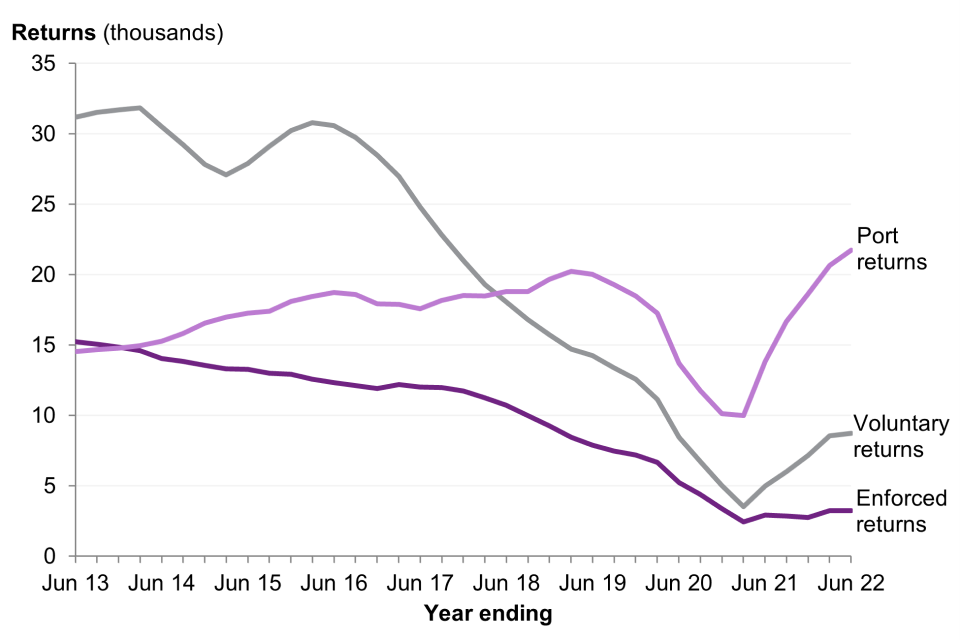
Source: Returns - Ret_D01
The longer-term fall in returns is due to a number of factors, including tighter screening of passengers prior to travel and changes in visa processes and regimes. The majority of enforced returns occurred from detention. As reported in the Home Office research ‘Issues raised by people facing return in immigration detention’, (Home Office, 2021), 73% of people detained within the UK following immigration offences in 2019 were recorded as having raised one or more ‘issues’ that may have prevented their return. These issues included raising an asylum claim, legal challenge, or a claim to be a potential victim of modern slavery or human trafficking.
Figure 6 shows that between 2016 and 2019, enforced returns of both EU and non-EU nationals declined (continuing the longer-term trend for non-EU nationals since 2012). Enforced returns of both EU and non-EU nationals have hovered around 400 people in recent quarters following the COVID-19 pandemic.
Figure 6: Enforced returns from the UK, for EU and non-EU nationals, year ending June 2013 to year ending June 2022
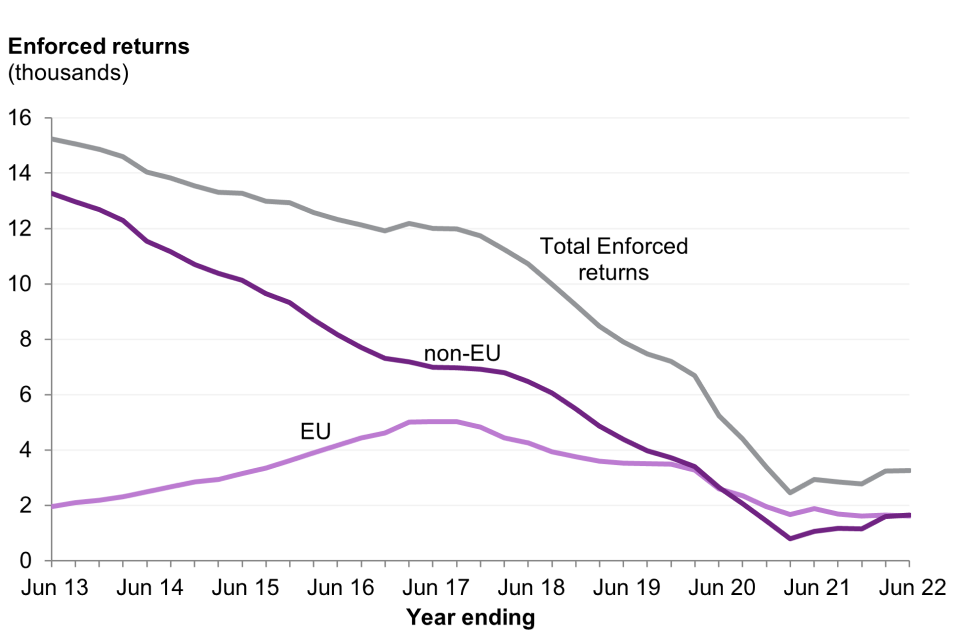
Source: Returns - Ret_D01
The top 4 nationalities for enforced returns were all European (3 from the EU) and accounted for almost two thirds of enforced returns in the year ending June 2022 – these were nationals of Albania (27%), Romania (19%), Poland (8%), and Lithuania (8%). This pattern represents a change from recent years, when Romania was the top nationality for enforced returns, and Albania second highest.
Most of these nationalities saw decreases in enforced returns in the year ending June 2022, compared with pre-pandemic in 2019. A notable exception was numbers of Albanian nationals which saw a slight increase (3%).
2.2 Returns of foreign national offenders (FNOs)
In the year ending June 2022, there were 2,867 FNOs returned from the UK, of which the majority (56%) were EU nationals (1,599) and 44% were non-EU nationals (1,268). FNO returns are a subset of total returns figures and in the year ending June 2022 constituted the vast majority of enforced returns and 24% of enforced and voluntary returns combined.
The figure of 2,867 FNO returns was 44% lower than in 2019 (5,128). Figure 7 shows that non-EU FNO returns have picked up slightly following the COVID-19 pandemic, driven by the increase in Albanian FNO returns. Overall, though, FNO returns have shown a downward trend since 2016, with the majority of FNOs returned being from the EU in every year since 2014.
Figure 7: Returns of FNOs1 from the UK, for EU and non-EU nationals, year ending June 2013 to year ending June 2022

Source: Returns - Ret_D03
Notes:
- An FNO is someone who is not a British citizen and is, or was, convicted in the UK of any criminal offence, or convicted abroad for a serious criminal offence.
2.3 Asylum related returns
Asylum related returns accounted for only 2% of total returns in the year ending June 2022.
In the year ending June 2022, there were 811 returns of people who had previously claimed asylum in the UK (see section 3.2 below for the definition of an asylum-related return). This was 76% fewer than in 2019 (3,332). This continued a downward trend since 2010, when there were 10,663 asylum-related returns. This may in part reflect the decrease in the number of asylum seekers whose claims are refused. In contrast, non-asylum related returns have shown a sustained increase driven by port returns and linked to when the UK left the EU (please see section 2.1 above for more info).
3. About the statistics
3.1 Immigration detention
The statistics in this section show the number of entries into, and departures from, detention for those held solely under immigration powers. One individual may enter or leave detention multiple times in a given period and will therefore have been counted multiple times in the statistics. Statistics on foreign nationals held in prison for criminal offences are published by the Ministry of Justice in ‘Offender management statistics quarterly’.
The detention estate comprises immigration removal centres (IRC), short-term holding facilities (STHF) and pre-departure accommodation (PDA).
The data exclude those held under immigration powers in HM prisons (prior to July to September 2017), police cells, short-term holding rooms at ports and airports (including Manston immigration processing centre), and those recorded as detained under both criminal and immigration powers and their dependants.
Data on those entering detention, by place of detention, relate to the place of initial detention. An individual who moves from one part of the detention estate to another will not have been counted as entering any subsequent place of detention. The data, therefore, do not show the total number of people who entered each part of the detention estate.
Data on those in detention relate to those in detention on the last day of the quarter and are therefore subject to daily fluctuations and can depend on how many people entered detention just before the end of the period.
Data on those leaving detention, by place of detention, relate to the place of detention immediately prior to being released. An individual who moves from one part of the detention estate to another has not been counted as leaving each part of the detention estate. The data, therefore, do not show the total number of people who left each part of the detention estate.
From July 2017, data on detention of immigration detainees in prisons are included in the immigration detention figures upon entering immigration detention within prison. Therefore, data from July to September 2017 onwards are not directly comparable with earlier data, as the length of detention will include time spent in prison under immigration powers prior to entering an IRC, STHF, or PDA. Further details of these changes can be found in the user guide.
Data on the number of children entering detention is subject to change. This will be as a result of further evidence of an individual’s age coming to light, such as an age assessment. Further details can be found in the user guide.
Data on deaths in detention include any death of an individual while detained under immigration powers in an IRC, STHF, PDA, under escort, or after leaving detention if the death was as a result of an incident occurring while detained or where there is some credible information that the death might have resulted from their period of detention and the Home Office has been informed. The annual data for 2021 are included in table Det_05b in the Detention summary tables. Further details can be found in the user guide.
Clandestine entrants to the UK may be held for short periods of time at a Short-Term Holding Facility (STHF) for processing where a short period of detention is required as a preliminary to resolving their position, before being dispersed to other appropriate accommodation. The Home Office has been receiving people for some time under the provisions of the STHF Rules 2018, in a number of Immigration Removal Centre (IRCs) and these individuals would be recorded as having entered detention even if that were for a short period, to support their reception and identification, before they are moved to other accommodation. The use of detention to receive new arrivals in this way is necessary to ensure people are safe and healthy on arrival, and their identities established, but this initial reception process for small boat arrivals is different to the well-established detention process for those people who are being prepared for return or are considered at risk of absconding.
3.2 Returns
Data on returns are published a quarter behind to allow more time for returns (particularly ‘other verified returns’) to be entered on the system prior to publication, ensuring that the published data are an accurate representation of the number of returns. We routinely revise the latest 8 quarters of data as part of each quarterly release. Therefore, data for the most recent 8 quarters should be considered provisional. Further details on the revisions can be found in the returns section of the user guide.
The statistics in this section show the number of returns from the UK. One individual may have been returned more than once in a given period and, if that was the case, would be counted more than once in the statistics.
The Home Office seeks to return people who do not have a legal right to stay in the UK. This includes people who:
- enter, or attempt to enter, the UK illegally (including people entering clandestinely and by means of deception on entry)
- are subject to deportation action; for example, due to a serious criminal conviction
- overstay their period of legal right to remain in the UK
- breach their conditions of leave
- have been refused asylum
The term ‘deportations’ refers to a legally defined subset of returns, which are enforced either following a criminal conviction, or when it is judged that a person’s removal from the UK is conducive to the public good. The published statistics refer to enforced returns which include deportations, as well as cases where a person has breached UK immigration laws, and those removed under other administrative and illegal entry powers that have declined to leave voluntarily. Figures on deportations, which are a subset of enforced returns, are not separately available.
Data on voluntary returns are subject to upward revision, so comparisons over time should be made with caution. In some cases, individuals who have been told to leave the UK will not notify the Home Office of their departure from the UK. In such cases, it can take some time for the Home Office to become aware of such a departure and update the system. As a result, data for more recent periods will initially undercount the total number of returns. ‘Other verified returns’ are particularly affected by this.
Asylum-related returns relate to cases where there has been an asylum claim at some stage prior to the return. This will include asylum seekers whose asylum claims have been refused and who have exhausted any rights of appeal, those returned under third-country provisions, as well as those granted asylum/protection but removed for other reasons (such as criminality).
In the ‘Immigration detention’ tables, the number of people ‘returned’ under ‘reason for leaving detention’ includes people who were refused entry at port in the UK who were subsequently detained and then departed the UK. However, in the ‘Returns’ tables, the number of returns from detention do not include those people, and so will be lower.
Prior to the UK leaving the EU, certain individuals applying for international protection (asylum) could be returned from the UK to the relevant EU member state that was deemed responsible for examining the application, under the Dublin Regulation. Data on returns, and requests for transfer out of the UK under the Dublin Regulation, by article and country of transfer, are available from the Asylum data tables. Strengthened inadmissibility rules came into effect on 1 January 2021, following the UK’s departure from the EU. Data on cases dealt with under the inadmissibility rules, for January 2021 to September 2022, can be found in the How many people do we grant protection to? section. Further details on the Dublin Regulation and inadmissibility rules are set out in the user guide.
Prior to the UK leaving the EU, nationals from the EU could be returned for abusing or not exercising Treaty rights or deported on public policy grounds (such as criminality).
Eurostat publishes a range of enforcement data from EU member states. These data can be used to make international comparisons.
3.3 Windrush Scheme
The Windrush generation refers to people from Caribbean countries who were invited by the British government between 1948 and 1971 to migrate to the UK as it faced a labour shortage due to the destruction caused by World War II. Not all of these migrants have documentation confirming their immigration status and, therefore, some may have been dealt with under immigration powers.
Data relating to the Windrush compensation scheme are published as part of the Home Office Transparency data.
4. Data tables
Data referred to here can be found in the following tables:
We welcome your feedback
If you have any comments or suggestions for the development of this report, please provide feedback by emailing MigrationStatsEnquiries@homeoffice.gov.uk. Please include the words ‘PUBLICATION FEEDBACK’ in the subject of your email.
We’re always looking to improve the accessibility of our documents. If you find any problems or have any feedback relating to accessibility, please email us.
See section 7 of the ‘About this release’ section for more details.
